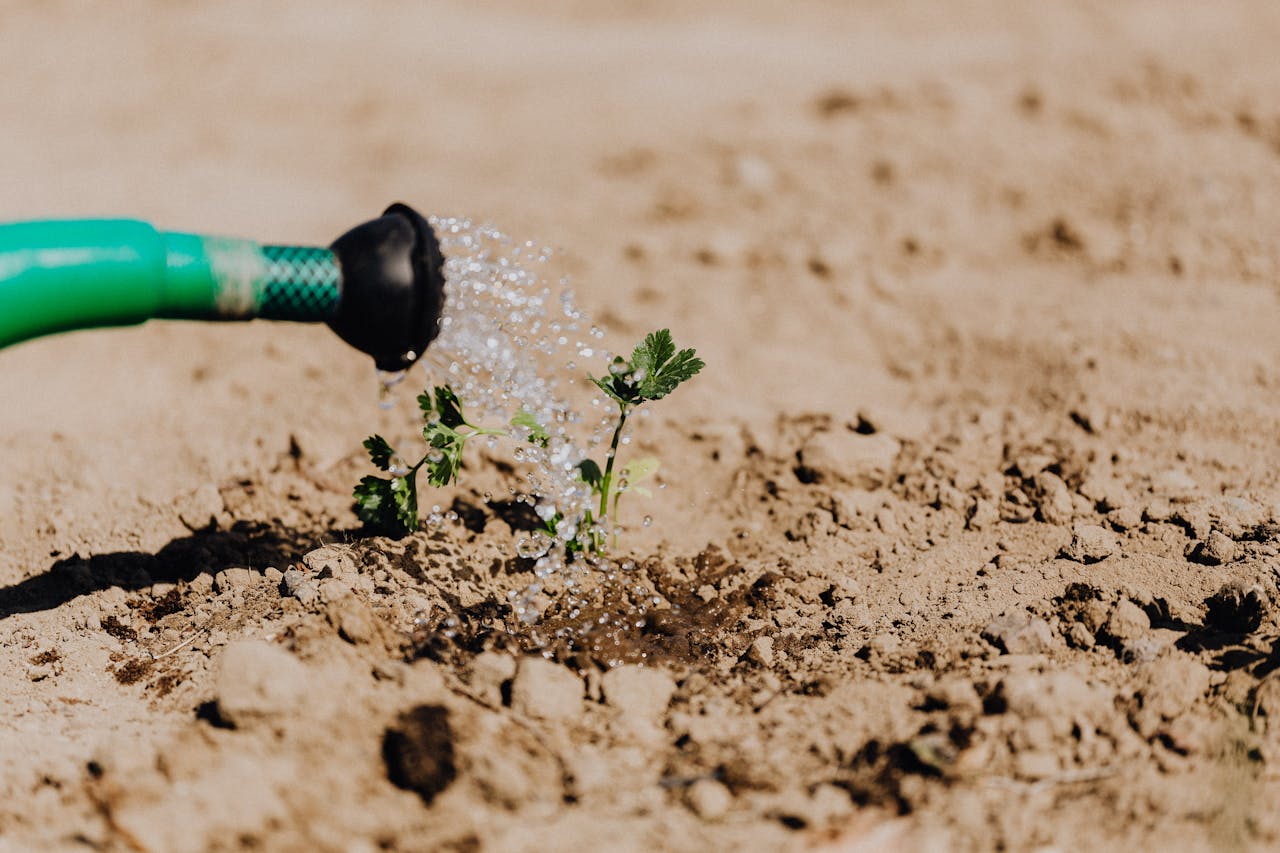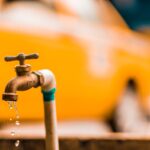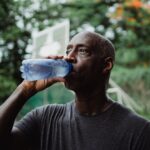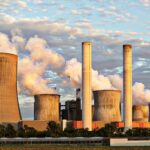How Water Shortages Affect the Food on Your Plate

Have you ever thought about how much water goes into the food on your plate? It’s not just the water you use to wash your vegetables or boil your pasta. Every bite you take has a hidden water story behind it.
Water shortages are becoming a big problem around the world. Some places don’t have enough rain, while others are using up their water supplies too quickly. This isn’t just a problem for drinking water, it’s also changing the food we eat every day.
Water’s Role in Agriculture
Farming needs a lot of water. When you see a big field of corn or wheat, imagine giant sprinklers watering those crops. This is called irrigation, and it’s how farmers make sure their plants get enough water to grow, especially in dry areas.
It’s not just plants that need water. Farm animals drink a lot too. A single cow can drink a bathtub full of water every day. And don’t forget all the water needed to grow the food that these animals eat.
There’s also something called “virtual water.” This is all the water that goes into growing and making our food before it reaches our plates. For example, it takes about 100 buckets of water to grow the wheat for just one loaf of bread.
Direct Effects of Water Shortages on Crop Production
When there isn’t enough water, crops suffer. Plants might grow smaller or produce less food. A corn plant might grow fewer or smaller ears of corn, for instance.
In really bad cases, crops can fail completely. Imagine a whole field of wheat turning brown and dying because there wasn’t enough rain. This is a farmer’s worst nightmare.
Water shortages can also change how food tastes and looks. Fruits might be smaller or less juicy. Vegetables might not be as crisp. Even the nutrients in our food can be affected when plants don’t get enough water.
Indirect Effects on Food Supply
When water is scarce and crops don’t grow well, food becomes more expensive. You might notice your grocery bill going up, especially for fresh fruits and vegetables.
Farmers might start growing different crops that need less water. This could mean fewer water-hungry foods like rice or almonds in the store, and more drought-tolerant foods like sorghum or chickpeas.
Some farmers might even move their farms to places with more water. This can change where our food comes from and how far it has to travel to reach us.
Impact on Specific Food Groups
Let’s look at how water shortages affect different types of food:
Grains and cereals, like wheat, rice, and corn, need a lot of water to grow. When water is scarce, we might see less of these staple foods, or they might become more expensive.
Fruits and vegetables are very sensitive to water. Not enough water can make fruits smaller or less sweet. Vegetables might be less crisp or flavorful. You might notice changes in your favourite produce at the supermarket.
Meat and dairy products are affected too, but in a less obvious way. Remember those thirsty cows? When water is scarce, it’s harder to raise animals and produce meat and milk. This can lead to higher prices for burgers, cheese, and other animal products.
These changes in our food supply due to water shortages aren’t just far-off problems. They’re already starting to affect the food on our plates, from the quantity and quality to the price and variety. Understanding this connection between water and food can help us make better choices about what we eat and how we use water.
Global Food Trade and Water Scarcity
Imagine the world as a big neighbourhood where countries are houses. Some houses have big water tanks (water-rich countries), while others have small ones (water-poor countries). Now, think of food as something these houses trade with each other.
Water-rich countries, like Brazil or Canada, often grow water-intensive crops and sell them to other countries. It’s like they’re sharing their big water tanks with the rest of the world. On the other hand, water-poor countries, such as those in the Middle East, might buy these water-intensive foods instead of trying to grow them with their limited water supplies.
This brings us to the idea of “virtual water trade.” When a country imports food, it’s also importing the water used to grow that food. For example, when Japan imports wheat from the United States, it’s essentially importing American water. This helps water-scarce countries save their own water, but it also means they depend on other countries for their food.
However, this system can cause problems. What happens if a water-rich country faces a drought and can’t export as much food? Suddenly, the water-poor countries that depend on these imports might not have enough to eat. This is why water scarcity isn’t just a local problem – it affects food security around the world.
Some countries are now thinking carefully about this “virtual water trade.” They’re asking questions like: Should we grow our own food to be more self-reliant, even if it uses up our limited water? Or should we import food from water-rich countries to save our water for other uses? These are tough questions without easy answers.
Consumer Choices and Water Footprints
Every time we eat, we leave a “water footprint” – the amount of water used to produce our food. Understanding this can help us make choices that save water.
Different foods have very different water footprints. For example:
- A single apple might need about 125 litres of water to grow.
- A kilogram of chicken requires around 4325 litres of water.
- A kilogram of beef? That’s about 15,415 litres.
This doesn’t mean we all need to become vegetarians, but being aware of these differences can help us make water-smart food choices.
Here are some ways we can reduce our water footprint through our food choices:
- Eat more plant-based meals: As you can see from the numbers above, plant foods generally use less water than animal products.
- Choose less water-intensive fruits and vegetables: Some crops need more water to grow than others. For example, watermelon and cucumber need plenty of water, while vegetables like okra and African eggplant (garden egg) can thrive with less. Even among our staples, there are differences. Cassava, for instance, is more drought-resistant than yam. By choosing more of these water-efficient options when we can, we’re helping to save water. Of course, we’re not saying to stop eating watermelon during harmattan – just be mindful of mixing in some less thirsty options in your meals when possible.
- Waste less food: When we throw away food, we’re also wasting all the water that went into growing it. Planning meals, using leftovers, and composting can help reduce this waste.
- Buy local and seasonal when possible: Food that’s grown locally and in-season often uses less water for irrigation and transport.
- Look for sustainably-produced food: Some farmers use water-saving techniques like drip irrigation or rainwater harvesting. Supporting these practices can encourage their spread.
Don’t forget that every little bit helps. If everyone made small changes in their food choices, it could add up to big water savings.
Another important aspect is reducing food waste. Globally, about one-third of all food produced is wasted. That’s not just wasted food, it’s wasted water too. By being mindful of what we buy, how we store food, and using up what we have before it spoils, we can significantly reduce our water footprint.
Some people are even starting to use apps or websites that calculate the water footprint of different meals. This can be an eye-opening way to understand the impact of our food choices on water resources.
By being more aware of the water that goes into our food, we can make choices that not only help conserve water but also support more sustainable farming practices. It’s a way for each of us to play a part in addressing global water scarcity, right from our own kitchens.
Technological Solutions in Agriculture
As water becomes more scarce, farmers and scientists are working together to find clever ways to grow food with less water. It’s like solving a giant puzzle, and technology is helping us find the pieces.
- One solution is more efficient irrigation systems. Instead of spraying water everywhere, these systems deliver water directly to the plant’s roots. Imagine a network of small pipes running through a field, giving each plant just the right amount of water it needs. This can save a lot of water compared to older methods.
- Scientists are also developing new types of crops that can grow with less water. These “drought-resistant” plants are like camels of the plant world – they can thrive even when water is scarce. For example, there are now types of corn that can produce a good harvest with much less water than traditional corn.
- Another exciting development is called precision agriculture. This uses technology like satellites, drones, and special sensors to monitor crops. Farmers can see exactly which parts of their fields need water, fertiliser, or other care. It’s like giving the farm a smart health tracker, helping farmers use resources more efficiently.
Policy Implications
Governments and international organisations have a big role to play in managing water for agriculture. It’s like being the referee in a game where everyone needs water, but there’s not enough to go around.
One challenge is balancing water use between farming and other needs, like supplying cities or protecting nature. Some countries are creating laws and policies to guide how water is used. For example, they might give incentives to farmers who use water-saving methods or put limits on how much water can be used for certain crops.
International cooperation is also crucial. Rivers and underground water sources often cross country borders. Countries need to work together to share these water resources fairly. Some regions have created agreements on how to share rivers or aquifers, but as water becomes scarcer, these agreements may be tested.
Future Outlook
Looking ahead, we can expect water to become even more precious. Climate change is likely to make rainfall less predictable in many parts of the world. At the same time, the global population is growing, which means we’ll need to produce more food.
To meet these challenges, we’ll need to adapt how we grow and consume food. This might mean:
- Shifting where we grow certain crops to match changing water availability
- Developing more drought-resistant crop varieties
- Improving irrigation and water management technologies
- Changing diets to include more water-efficient foods
Consumer awareness will play a big role. As more people understand the water footprint of their food choices, it could drive changes in what we eat and how food is produced.
Conclusion
The connection between water shortages and the food on our plates is clear and significant. From the farm to our forks, water plays a crucial role in every step of food production. As we face increasing water scarcity, it’s vital that we all – from policymakers to farmers to consumers – play our part in using water more wisely.
This is where organisations like AquaMaya get in the mix. While our primary focus at AquaMaya is on providing clean water access in West Africa, our work has far-reaching implications for food security as well. By ensuring communities have access to clean water, AquaMaya is not only improving health but also freeing up water resources that can be used for sustainable agriculture.
Our approach of working closely with local communities and implementing sustainable solutions aligns perfectly with the need for community-based approaches to water management in agriculture. AquaMaya’s efforts in educating communities about water conservation and hygiene practices can have a positive ripple effect on how water is used in small-scale farming, which is crucial for food security in many parts of West Africa.
Moreover, by reducing the time and effort people spend collecting water, our projects allow community members to dedicate more time to productive activities, including agriculture. This can lead to improved food production at the local level, contributing to better nutrition and food security.
As we consider the global challenges of water scarcity and its impact on our food systems, supporting organisations like ours becomes even more critical. work demonstrates how addressing water scarcity at the community level can have wide-ranging benefits, including on food production and security.
In conclusion, the story of water and food is one that touches us all. Every meal we eat is a reminder of the precious water resources that went into producing it. By making water-wise food choices, supporting sustainable agriculture, and backing initiatives like ours at AquaMaya that address water scarcity at its roots, we can all contribute to a future where clean water and nutritious food are available to everyone. Remember, every drop counts, and every bite matters in our collective effort to manage our water resources wisely.
Sources:
- https://www.un.org/waterforlifedecade/food_security.shtml
- https://watercalculator.org/footprint/what-is-virtual-water/
- https://www.theguardian.com/news/datablog/2013/jan/10/how-much-water-food-production-waste
- https://www.oxydus.com/blog/how-does-a-water-shortage-impact-the-food-supply
- https://earth.org/how-water-shortage-impact-food-security/
- https://www.waterfootprint.org/water-footprint-2/what-is-water-footprint-assessment/
- https://www.bbcgoodfood.com/howto/guide/your-diet-contributing-water-scarcity
- https://news.climate.columbia.edu/2011/07/01/wasting-food-wasting-water/
- https://www.waterfootprint.org/resources/Report12.pdf
- https://www.fao.org/4/mb060e/mb060e00.htm
- https://www.waterfootprint.org/resources/interactive-tools/extended-water-footprint-calculator/






